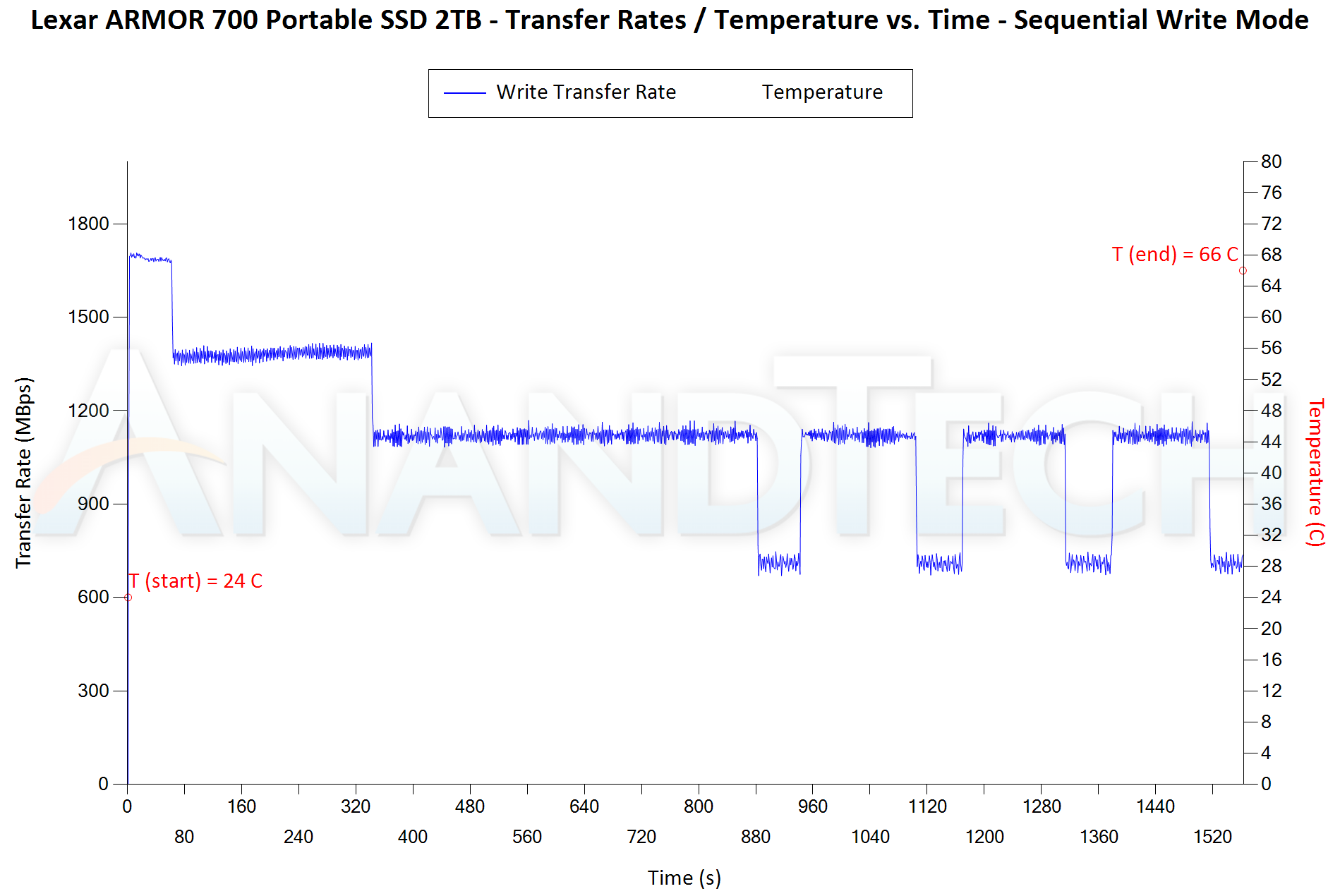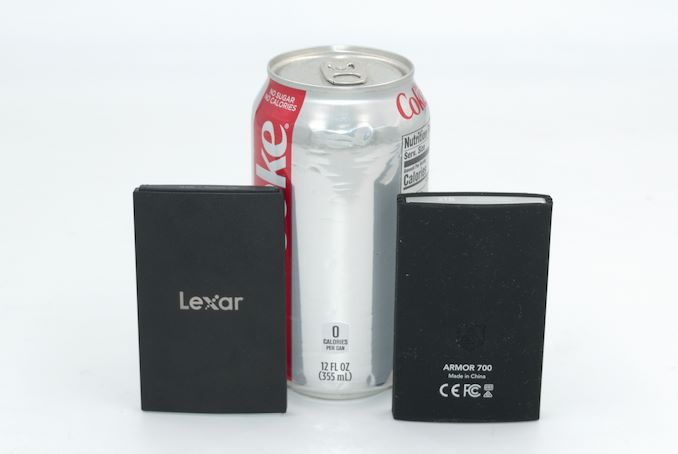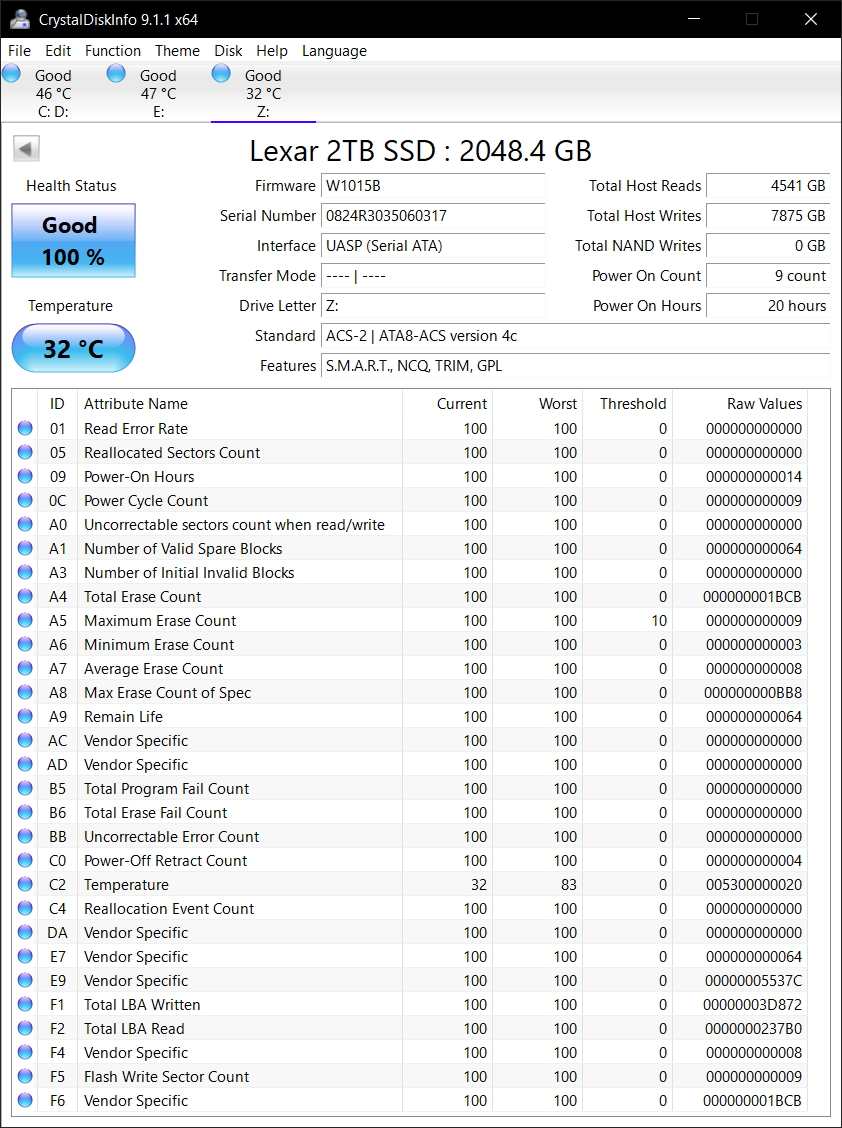Lexar ARMOR 700 Portable SSD Review: Power-Efficient 2 GBps in an IP66 Package
by Ganesh T S on May 30, 2024 8:00 AM EST- Posted in
- Storage
- SSDs
- Lexar
- DAS
- Silicon Motion
- External SSDs
- YMTC
- Portable SSDs
Miscellaneous Aspects and Concluding Remarks
The performance of the PSSDs in various real-world access traces as well as synthetic workloads was brought out in the preceding sections. We also looked at the performance consistency for these cases. Power users may also be interested in performance consistency under worst-case conditions, as well as drive power consumption. The latter is also important when used with battery powered devices such as notebooks and smartphones. Pricing is also an important aspect. We analyze each of these in detail below.
Worst-Case Performance Consistency
Flash-based storage devices tend to slow down in unpredictable ways when subject to a large number of small-sized random writes. Many benchmarks use that scheme to pre-condition devices prior to the actual testing in order to get a worst-case representative number. Fortunately, such workloads are uncommon for direct-attached storage devices, where workloads are largely sequential in nature. Use of SLC caching as well as firmware caps to prevent overheating may cause drop in write speeds when a flash-based DAS device is subject to sustained sequential writes.
Our Sequential Writes Performance Consistency Test configures the device as a raw physical disk (after deleting configured volumes). A fio workload is set up to write sequential data to the raw drive with a block size of 128K and iodepth of 32 to cover 90% of the drive capacity. The internal temperature is recorded at either end of the workload, while the instantaneous write data rate and cumulative total write data amount are recorded at 1-second intervals.
| Sequential Writes to 90% Capacity - Performance Consistency | |
| TOP: | BOTTOM: |
 |
|
 |
|
The Lexar ARMOR 700 2TB offers a peak speed of 1700 MBps for this access pattern and sustains it for around 60s, pointing to a SLC cache of around 102 GB (actual size is probably a bit smaller, given the background folding in the picture). Beyond that, the drive offers three other performance levels, and the drive switches between them (probably based on thermals, as the lowest performance state and the one just above it are switched back and forth). These levels correspond to 1400 MBps, 1150 MBps, and 700 MBps. is able to sustain around 1300 MBps all through. We only tracked the temperature at the beginning and end of the process, and found the worst-case value to be 66C. Only the Kingston XS2000 is worse off at 72C in terms of thermal performance.
These numbers track our findings in the previous benchmark section. The Lexar ARMOR 700 delivers good performance numbers for workloads as long as the SLC cache is in play. Unlike the SL500 with its controlled peak speeds fitting in with the thermal solution, the ARMOR 700 finds itself throttling down to sub-1 GBps numbers under sustained stress.
Power Consumption
Bus-powered devices can configure themselves to operate within the power delivery constraints of the host port. While Thunderbolt ports are guaranteed to supply up to 15W for client devices, USB 2.0 ports are guaranteed to deliver only 2.5W (500mA @ 5V). In this context, it is interesting to have a fine-grained look at the power consumption profile of the various external drives. Using the ChargerLAB KM003C, the bus power consumption of the drives was tracked while processing the CrystalDiskMark workloads (separated by 5s intervals). The graphs below plot the instantaneous bus power consumption against time, while singling out the maximum and minimum power consumption numbers.
| CrystalDiskMark Workloads - Power Consumption | |
| TOP: | BOTTOM: |
 |
|
 |
|
Despite the firmware differences, the power consumption profile is remarkably similar for all the 2TB SM2320-based PSSDs. The SL500 with its lower capacity has slightly lower absolute peak numbers (3W vs. 4W), but all the SM2320 PSSDs spend most of the active time around the 2W mark. Unlike the LaCie Rugged Mini, the Lexar ARMOR 700 does have a true deep sleep mode after idling for around 20 minutes.
Final Words
The Lexar ARMOR 700 was introduced at CES 2024 along with a host of other PSSD solutions. Lexar's Silicon Motion SM2320-based solutions like the ARMOR 700 and SL500 differentiate themselves from others in two aspects - usage of YMTC's 128L 3D TLC and the availability of hardware encryption support. The company seems to be targeting different capacities for different markets. The US market currently seems to only have the 2TB SKU available for $210. With prices of flash-based storage in a flux, it is not possible to make any comments on the value proposition of the Lexar ARMOR 700. However, based on current prices, the Crucial X10 Pro 2TB at $175 and the the LaCie Rugged Mini 2TB at $190 seem to offer better value for money. That said, the case design of the ARMOR 700 is subjectively more pleasing than either alternative. It also feels much more solid in hand compared to the X10 Pro, while also being smaller in size compared to the Rugged Mini.

(L) Lexar SL500 (R) Lexar ARMOR 700
Our only quibble with the Lexar ARMOR 700 is the absence of a credible thermal solution. Having configured the firmware for higher peak speeds compared to the SL500, Lexar could have optimized the thermal solution to take full advantage of it, but that is unfortunately not the case. Lexar does have a gamer-focused 2GBps-class PSSD in the older SL660 BLAZE with thermal pads, but it uses older flash (similar to the one in the Kingston XS2000) and is not as performant as the ARMOR 700.

7.8TB+ writes, and 4.5TB+ reads at the end of our testing routine
The design of the casing is subjectively much better than almost all of the other SM2320-based PSSDs, and the ruggedness / IP66 rating is the icing on the cake. The SLC cache size at around 100 GB is acceptable for most consumer / casual user workloads. In any case, the direct-to-TLC writes are also quite good at 1.4 GBps (thermals permitting). Overall, this is a win for direct-attached storage workloads. On the general usage front, the random access numbers and the behavior for mixed workloads are a bit off - but it is unfair for consumers to expected native controller solutions to perform as well as bridge-based solutions using DRAM-equipped SSDs in that aspect. Overall, the Lexar ARMOR 700 shows the flexibility offered by Silicon Motion's SM2320 solution in good light. Depending on the exact use-case, consumers may find it a good alternative to the Lexar SL500, Crucial X10 Pro, LaCie Rugged Mini, or the Kingston XS2000.










1 Comments
View All Comments
artifex - Thursday, May 30, 2024 - link
Looks like in the comparative configuration chart, the drop-down for the LaCie Rugged Mini 2TB shows a mislabeled review link claiming it's for the Crucial X10 Pro 2TB, but it does go to the proper review.